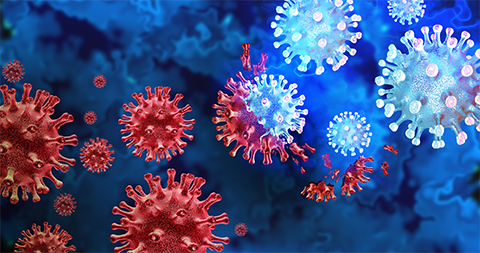A great escape — how SARS-CoV-2 evades our defenses
Pathogens that invade humans confront many host mechanisms that prevent infection and its spread. The complement system is an integral part of the innate immune system, the body’s first line of defense against pathogens.
The complement system surveys, tags and clears pathogens using a tightly controlled network of approximately 35 plasma- and membrane-bound proteins activated by the classical pathway, the alternative pathway or the lectin pathway. Each of these complement pathways has unique mechanisms that help the system clear an array of pathogens and cellular debris.

On the other side of the arms race, pathogens that infect humans have evolved strategies to escape the complement system. SARS-CoV-2, the causative agent of COVID-19, is no different.
Clinical studies show that in severe cases of COVID-19, the SARS-CoV-2 infection triggers hyperactivation of the complement system. However, scientists do not yet understand the mechanism by which SARS-CoV-2 evades the system.
Surajit Ganguly’s research at Jamia Hamdard in India focuses on understanding how pathogens modulate the functions of neurons via interactions between the nervous and immune systems. During the COVID-19 pandemic, the Ganguly lab focused on identifying mechanisms by which SARS-CoV-2 evades the immune system.
“India went into total lockdown … from the middle of March 2020, and being shunned out of the lab is the last thing a neuroscientist wants,” Ganguly said. “So using bioinformatics skills was the best option my team was left with during the height of the pandemic.”
In a recent article in the Journal of Biological Chemistry, the team provides preliminary evidence that SARS-CoV-2 bypasses the activated complement system using molecular mimicry in which the ORF8 viral protein mimics a human complement protein, Factor I, or FI.
During a coronavirus outbreak in 2003, Ganguly was at the National Institutes of Health in Maryland, he said.
“I vaguely remembered talking to one virologist during that time, who said the disappearance of SARS-CoV coincided with a major mutation on the sequence that produced the viral accessory protein known as ORF8,” he said.
Relying on that information, Ganguly extracted the first published protein sequence of ORF8 from SARS-CoV-2 and started looking for a match in the human protein data bank.
The team found that the SARS-CoV-2 ORF8 protein had sequence similarities to FI, suggesting the two proteins could have a common interacting factor in the host cells, the C3b protein. The C3b protein is a component of the alternative pathway, or AP, and of the activated form of Factor C3 complement protein. Tagging of pathogens by C3b, also called opsonization, marks them for destruction by phagocytic cells.
The FI protein cleaves peptide bonds in C3b protein and downregulates the complement activation pathways to avoid destruction of host cells. FI binds C3b to prevent hyperactivation of the AP by cleaving C3b into smaller peptides.
Using a combination of in silico protein docking analysis, coimmunoprecipitations, AP C3-convertase and cofactor assays, the Ganguly lab’s study shows that the SARS-CoV-2 ORF8 protein binds to complement C3/C3b, preventing the binding to other cofactors required for activation and regulation of the AP pathway.
“We have highlighted a moonlighting function of the SARS-CoV-2 encoding ORF8 protein,” Ganguly said. “Targeting ORF8 could be a strategy to help our immune system overpower the infectivity of the virus.”
Enjoy reading ASBMB Today?
Become a member to receive the print edition four times a year and the digital edition monthly.
Learn moreGet the latest from ASBMB Today
Enter your email address, and we’ll send you a weekly email with recent articles, interviews and more.
Latest in Science
Science highlights or most popular articles

Bacteriophage protein could make queso fresco safer
Researchers characterized the structure and function of PlyP100, a bacteriophage protein that shows promise as a food-safe antimicrobial for preventing Listeria monocytogenes growth in fresh cheeses.

Building the blueprint to block HIV
Wesley Sundquist will present his work on the HIV capsid and revolutionary drug, Lenacapavir, at the ASBMB Annual Meeting, March 7–10, in Maryland.

Gut microbes hijack cancer pathway in high-fat diets
Researchers at the Feinstein Institutes for Medical Research found that a high-fat diet increases ammonia-producing bacteria in the gut microbiome of mice, which in turn disrupts TGF-β signaling and promotes colorectal cancer.

Mapping fentanyl’s cellular footprint
Using a new imaging method, researchers at State University of New York at Buffalo traced fentanyl’s effects inside brain immune cells, revealing how the drug alters lipid droplets, pointing to new paths for addiction diagnostics.

Designing life’s building blocks with AI
Tanja Kortemme, a professor at the University of California, San Francisco, will discuss her research using computational biology to engineer proteins at the 2026 ASBMB Annual Meeting.

Cholesterol as a novel biomarker for Fragile X syndrome
Researchers in Quebec identified lower levels of a brain cholesterol metabolite, 24-hydroxycholesterol, in patients with fragile X syndrome, a finding that could provide a simple blood-based biomarker for understanding and managing the condition.

